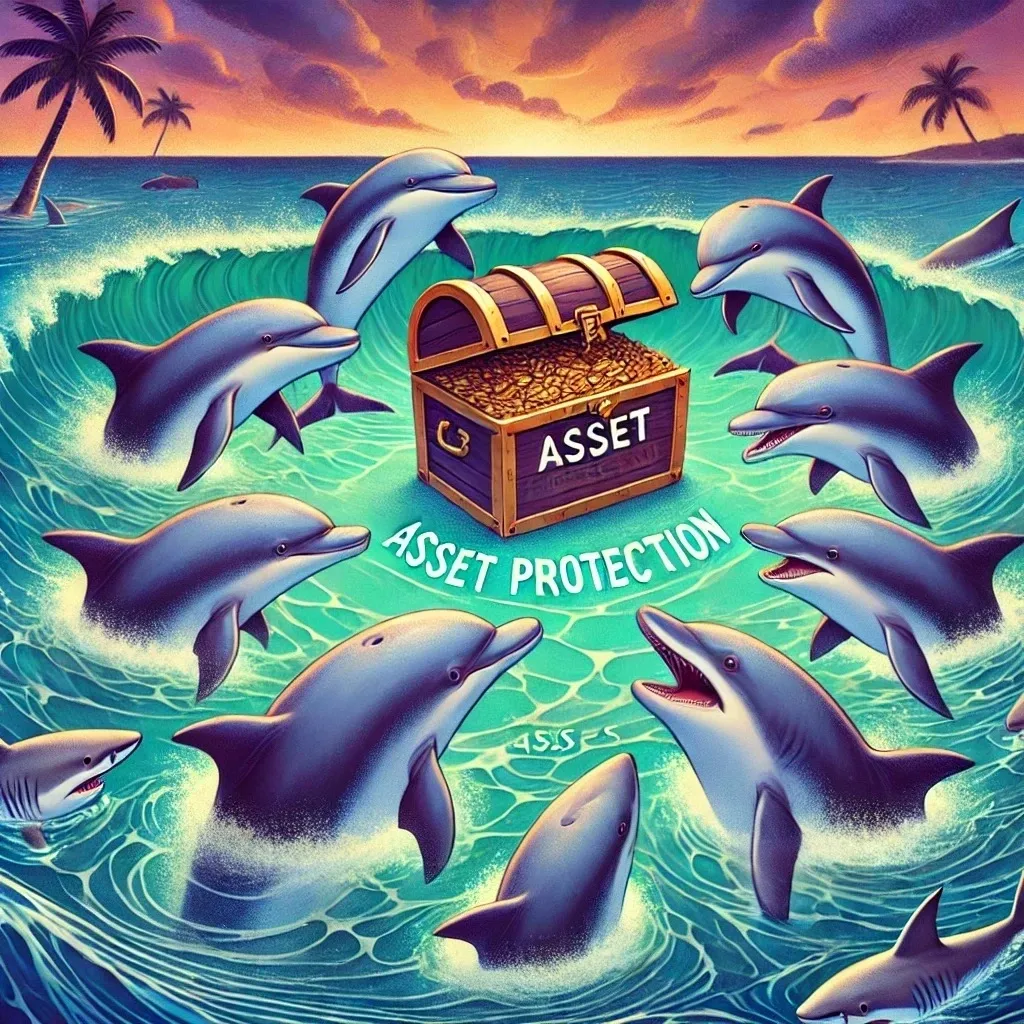Introduction: Why Dolphins and Sharks Should Never Swim Together
Imagine dolphins and sharks swimming in the same waters. Dolphins are smart and protective, working together to keep threats at bay. But introduce sharks into the mix, and chaos is inevitable.
In financial planning, dolphins represent asset protection strategies—agile, strategic, and designed to shield you from lawsuits and creditors. Sharks symbolize taxes—aggressive, relentless, and always circling for opportunities.
Mixing these two worlds is dangerous. It invites audits, penalties, and legal trouble from the IRS. Let’s dive into why asset protection and taxes must remain separate and how you can safeguard your financial future.
What Is Asset Protection? (Dolphins in Action)
Asset protection is about creating barriers between your wealth and potential threats, such as lawsuits, creditors, and unexpected financial claims. Tools like trusts, LLCs, and offshore accounts serve as the dolphins of the financial world. They form a protective pod around your assets, keeping them secure.
However, some people mistakenly believe that asset protection can also help avoid taxes. This misconception leads to dangerous financial practices and severe consequences. You have no idea how many times a week I get this call …. “I want to create an asset protection plan to avoid paying taxes.” This kind of thinking is like asking dolphins to swim with sharks. The outcome? Disaster.
Why Asset Protection and Taxes Don’t Mix
Here are the three main reasons asset protection and tax strategies should never overlap:
1. Different Objectives
• Asset Protection: Shields your wealth from lawsuits and creditors.
• Tax Planning: Minimizes your tax liability.
Mixing the two dilutes the effectiveness of both and puts your financial strategies at risk.
2. IRS Scrutiny
Using asset protection tools to avoid taxes is like sending an open invitation to the IRS. This can lead to audits, penalties, and even accusations of tax evasion.
3. Legal Consequences
Courts consistently rule against individuals who misuse asset protection tools for tax purposes. Penalties include fines, asset forfeiture, and reputational damage.
Case Studies: What Happens When Dolphins and Sharks Mix
Case 1: Fifth Third Bank v. Sisto, 2013
The defendant transferred assets to an offshore trust just before debts arose. The court deemed the transfer fraudulent, reversing it and penalizing the defendant for attempting to evade creditors and taxes.
Case 2: United States v. Lacey, District Court of AZ (2021)
The defendant used offshore transactions to claim both tax benefits and asset protection. The court ruled these transactions as tax avoidance schemes, resulting in substantial penalties and financial ruin.
Case 3: United States v. Sullivan, 274 U.S. 259 (1927)
In this landmark case, a businessman failed to report significant foreign income, claiming it wasn’t taxable. The Supreme Court ruled that U.S. citizens must pay taxes on worldwide income, setting a precedent for the IRS’s authority.
How to Keep Dolphins and Sharks Apart
To ensure compliance and effectiveness, adopt a tax-neutral approach to asset protection:
1. Separate Asset Protection and Tax Planning
Work with experts in each field. Asset protection specialists will safeguard your wealth, while tax advisors focus on working within the tax code to minimize your tax liability legally.
2. Focus on Compliance
Strategies like the Bridge Trust are designed to be tax-neutral—providing protection without raising red flags with the IRS. Other offshore asset protection trusts like Belize, the Caymans, and the Bahamas are not.
3. Stay Updated on Regulations
Tax laws and asset protection rules evolve constantly. Staying informed ensures your strategies remain effective and compliant.
The Bridge Trust: Your Ultimate Dolphin Pod
The Bridge Trust is one of the most effective tools for protecting your wealth. It’s like having the smartest pod of dolphins working tirelessly to guard your assets.
Why the Bridge Trust Stands Out
• Domestic Simplicity: Easy to set up and manage as a domestic trust.
• Offshore Strength: Seamlessly transitions offshore when legal threats arise, creating a nearly impenetrable barrier.
The Bridge Trust offers powerful asset protection without mixing strategies or inviting IRS scrutiny.
Conclusion: Protect Your Financial Ocean
In the financial world, dolphins and sharks don’t mix—and neither should asset protection and taxes. Dolphins (asset protection) guard your wealth from lawsuits and creditors, while sharks (taxes) are a separate reality requiring careful, legal planning.
The Key to Success:
Let your dolphins focus on safeguarding your assets, while a dedicated tax strategy ensures compliance.
Take Action: Build Your Dolphin Pod Today
Don’t let sharks invade your financial ocean. Contact our team of asset protection lawyers for a FREE consultation.
We’ll design a tax-neutral asset protection plan that keeps lawsuits and creditors at bay while ensuring full compliance with tax laws.
Protect Your Wealth the Right Way—Safely, Legally, and Effectively.
Call today for a legal consultation with an asset protection lawyer at (888) 773-9399
By: Brian T. Bradley, Esq.




